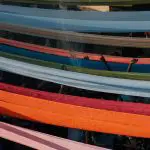When it comes to tackling stains, knowing your fabric types is crucial for effective removal. You've probably encountered stubborn marks on cotton, silk, or wool, and each requires a tailored approach. For instance, while cotton can handle a bold detergent, delicate fabrics demand a gentle touch. If you think you've tried every trick in the book, there's still more to uncover about specific techniques that could save your favorite items. Curious about how to master these methods and protect your investments? Let's explore the nuances of stain removal for various fabrics.
Table of Contents
Key Takeaways
- Identify the fabric type before treating stains to apply the appropriate cleaning method for effective removal.
- Act quickly to blot spills and stains; avoid rubbing to prevent spreading and damaging fibers.
- For cotton, address food stains by scraping residue, rinsing, and applying a detergent mixture.
- Use cornstarch or talcum powder on oil-based stains across delicate fabrics to absorb excess oil before treatment.
Understanding Fabric Types
To effectively tackle stain removal, it's crucial to understand the different fabric types you'll encounter in your wardrobe. Each fabric reacts uniquely to stains and cleaning methods, so knowing what you're dealing with can save you time and frustration.
Start with cotton, a durable and versatile fabric. It's generally safe for most cleaning methods, but always check labels for specific care instructions.
Next, consider polyester, which is more resistant to stains and wrinkling but can hold onto odors. You'll want to use a gentle approach to avoid damaging it.
Silk demands special attention. It's delicate, and using harsh chemicals can ruin its texture. For silk, stick to mild detergents and cold water.
Linen, while breathable and stylish, wrinkles easily and can stain if not treated promptly, so act fast.
Wool is another fabric to watch out for; it's prone to shrinking. Use cold water and avoid heavy agitation.
Lastly, blends, which combine different fibers, may require a tailored approach depending on their makeup. Understanding these fabric types helps you choose the right methods for effective stain removal, preserving your garments for the long haul.
Common Stains and Solutions
Common stains can easily disrupt your day, but knowing the right solutions can quickly restore your fabrics. Whether it's coffee, wine, or grease, you'll face these pesky stains at some point.
For coffee stains, act fast. Blot the area with a paper towel, then mix one tablespoon of liquid dish soap, one tablespoon of white vinegar, and two cups of cold water. Apply this solution, and rinse.
Wine stains? Don't panic! Sprinkle salt on the stain to absorb the liquid. After a few minutes, rinse it with cold water. If it lingers, use a mixture of hydrogen peroxide and dish soap in equal parts.
Grease stains require a different approach. Sprinkle baking soda directly on the stain to absorb the grease, then let it sit for 10-15 minutes. Brush off the baking soda and apply a bit of dish soap to the area. Rinse with warm water.
Techniques for Cotton Fabrics
When tackling stains on cotton fabrics, specific techniques can help you effectively restore their original look.
First, identify the type of stain—whether it's food, oil, or ink—since this will guide your removal approach.
For food stains, act quickly by scraping off any residue and rinsing with cold water. Apply a mixture of liquid laundry detergent and water directly to the stain, letting it sit for about 5-10 minutes before washing.
For oil-based stains, sprinkle baking soda or cornstarch on the area to absorb excess oil. After 15-30 minutes, brush it off, and treat the stain with a grease-fighting dish soap. Let it sit for a few minutes before rinsing.
When dealing with ink, blot the stain gently with rubbing alcohol on a cotton ball. Avoid rubbing, as it can spread the ink. Rinse and then launder as usual.
Always check the care label before applying any treatment, and test any solution on a hidden area first to ensure it won't damage the fabric.
Methods for Delicate Materials
Delicate fabrics like silk or chiffon require gentle stain removal methods to preserve their beauty and integrity. When dealing with stains on these materials, it's crucial to act quickly but carefully.
Start by blotting the stain with a clean, dry cloth to absorb as much as possible without rubbing, which can damage the fibers.
For water-based stains, a mixture of cool water and a few drops of mild detergent works wonders. Dampen a soft cloth with the solution and gently dab the stain, being sure not to saturate the fabric. Rinse with a clean damp cloth afterward to remove any soap residue.
For oil-based stains, sprinkle a small amount of cornstarch or talcum powder on the area. Let it sit for about 15 minutes to absorb the oil, then gently brush it off. If the stain persists, consider taking the fabric to a professional cleaner.
Tips for Upholstery Care
Proper upholstery care is key to maintaining the longevity and appearance of your furniture, much like how gentle techniques protect delicate fabrics.
Start by vacuuming your upholstery regularly to remove dust and debris, which can wear down fibers over time. Use a soft brush attachment to avoid damaging the fabric.
When spills happen, act quickly. Blot the stain gently with a clean cloth instead of rubbing, which can spread the stain. For water-based stains, a mixture of mild soap and water works well. Test any cleaning solution on an inconspicuous area first to ensure it doesn't discolor the fabric.
Consider using fabric protectors to create a barrier against stains and spills. These products can make cleanup easier and extend the life of your upholstery.
Additionally, rotate cushions periodically to ensure even wear. If your furniture gets heavy use, consider professional upholstery cleaning every few years to keep it looking fresh.
Lastly, avoid direct sunlight, as it can fade colors over time. By following these tips, you'll keep your upholstery looking beautiful and resilient for years to come.
Frequently Asked Questions
What Household Items Can I Use for Stain Removal?
You can use items like baking soda, vinegar, dish soap, and hydrogen peroxide for stain removal. These household staples effectively tackle many stains, making your cleaning process easier and more efficient without needing specialized products.
How Can I Prevent Stains on My Clothes?
To prevent stains on your clothes, wear aprons while cooking, avoid sitting on dirty surfaces, and treat spills immediately. Regularly check for stains before washing, and consider using fabric protectors for added defense.
Are There Any Stains That Cannot Be Removed?
Yes, some stains can be extremely stubborn and might not come out completely, especially if they've set in. It's essential to act quickly and use the right products to improve your chances of removal.
How Do I Test a Fabric for Colorfastness?
To test a fabric for colorfastness, dampen a small, hidden area with water, then blot it with a white cloth. If color transfers, the fabric isn't colorfast, and you should proceed with caution when cleaning.
Should I Wash Stained Fabric Before Treating It?
You shouldn't wash stained fabric before treating it. Washing can set the stain, making it harder to remove. Instead, treat the stain first, then wash once it's lifted to ensure the best results.
- Scrim as a Substrate: Its Use in Foils, Flooring, and Packaging - June 26, 2025
- Technical Review: The Properties of Type 108 Fabric Scrim Cloth - June 26, 2025
- The Manufacturing Process: How Fiberglass Scrim Mesh Is Made - June 26, 2025





